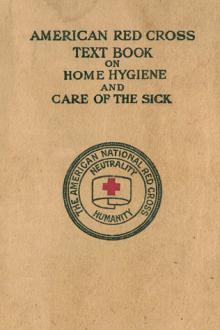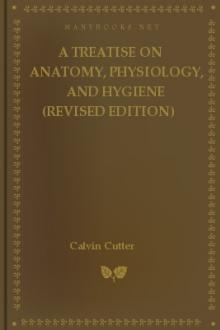American Red Cross Text-Book on Home Hygiene and Care of the Sick by Isabel McIsaac (best affordable ebook reader txt) 📕

- Author: Isabel McIsaac
- Performer: -
Book online «American Red Cross Text-Book on Home Hygiene and Care of the Sick by Isabel McIsaac (best affordable ebook reader txt) 📕». Author Isabel McIsaac
—The genital organs of girl babies should be gently washed twice a day, using absorbent cotton, and tepid water. Treatment other than cleanliness is ordinarily unnecessary. Vaseline may be applied if the genitals are slightly reddened; any discharge or abnormal appearance should be reported to the doctor. In the case of boy babies the foreskin should be gently drawn back twice a week after immersion in the tub; after the parts have been gently washed with absorbent cotton, it should be drawn forward again. No force should be employed in retracting the foreskin; the physician should be consulted if it cannot be retracted easily.
—During his first few months crying is a child's only means of expression, and he quickly learns to make effective use of his limited opportunities. It is important for the mother to distinguish between crying caused by pain, illness, or hunger, and crying caused by temper. These cries are more or less distinctive, but no one can be sure in every case just what a crying baby is attempting to express.
A cry caused by hunger is fretful and often interrupted by sucking the thumb; it ceases when the child is fed. A cry caused by indigestion is similar; the child is relieved for a short time by feeding, but soon begins to cry again. If he has acute pain, such as earache, the cry is sharp, repeated at frequent intervals and accompanied by other symptoms of distress, such as restlessness, contraction of the features, and drawing up the legs. In serious illness the cry is usually feeble, fairly constant except when the child is asleep, and exaggerated by slight causes.
A limited amount of crying is useful exercise for a baby, and should not distress his mother unduly. Moreover, crying may be merely the expression of a wish to be taken up, to be played with, carried about or otherwise amused, to be given a pacifier, or to be indulged in other bad habits. If not indulged in these ways he may cry from temper. The cry of temper is loud and violent, accompanied by vigorous kicking or by holding the body rigid. Proper treatment of the baby may prevent many months of discomfort, and spare him the formation of his first bad habit. All other possible causes for crying should be eliminated. If the child continues to cry when he is warm and dry and comfortable, "It should simply be allowed to cry it out. This often requires an hour and in extreme cases two or three hours. A second struggle will seldom last more than ten or fifteen minutes and a third will rarely be necessary" (Holt). Gas may form in the child's stomach during prolonged crying. It is consequently permissible to take him up after 15 minutes, and hold him erect; he generally expels gas at once, and immediately experiences relief. As soon as he is relieved, he should go back to his crib.
—Exercise is essential to the development of the body, but during the first few weeks warmth and quiet are so important that a baby should not be disturbed except for necessary care. His position, however, should be changed occasionally; if he lies on the same side constantly the soft bones of the head may become misshapen from pressure. As the baby grows older he needs more exercise, and he may be given an opportunity for it by removing his outer clothing and placing him on a bed in a warm room for a short time each day. Unnecessary handling is not good for a baby at any age.
After he becomes more active, he may play on a mattress or thick blanket placed on the floor. The blanket should be covered with a washable pad or rubber cloth and clean sheet, and the whole should be surrounded by a fence at least two feet high. In such an enclosure a baby may safely be left to play if protected from draughts and cold. Elevated pens that can be folded when not in use are more convenient but more expensive than the home-made arrangement. As soon as a child begins to run about he takes ample exercise, and he may even need to be guarded from too great fatigue, especially toward bedtime. Games and play should be adapted to the age of the child and sufficiently varied to exercise all portions of the body; but they should not be too violent nor too prolonged. Some supervision of children's play is necessary, but they should be given as much freedom as possible and allowed to develop their own initiative.
—The desire for play does not develop until a child is about six months old. At this age toys that can be washed, such as those of hard or soft rubber, should be selected. A baby instinctively carries everything to his mouth,—first his thumb, then playthings, and later whatever he may find, no matter how unsuitable. For his safety and protection this habit should be overcome as soon as possible, and he must learn to put nothing in his mouth except food and drink. Relatives are nearly always tempted to give too many and too fragile toys; they merely teach a child to be destructive and constantly to expect something new. Toys are the first possessions of which a child is conscious, and through them many desirable qualities may be developed: neatness and order, gentleness and a feeling of protection toward the helpless doll or Teddy bear, and unselfishness in sharing special treasures with playmates. Later the child may be given pets and made responsible for their care; but animals should not be subjected to unintentional cruelties from small children.
EXERCISES What two factors are chiefly responsible for the deaths of babies under a year old? What other factors contribute? In your city or town what is the number of deaths per 1000 births of babies under one year old? Why is birth registration important to an individual? to a community? Is it required by law in your city? What is the average weight of babies at birth? Describe the rate at which they should gain. At what age may a normal child be expected to sit erect? to stand? to walk? to speak? When should his first teeth appear? his permanent teeth? Describe normal bowel movements of a baby. How should a young baby be dressed? Describe a baby's bath and toilet. Describe the surroundings that are suitable for a baby. What is the best food for a healthy baby? Why? Describe in detail a good daily program for a healthy baby four months old. What habits are desirable for a baby to form, and how may he be trained so that he will form them? Name all the indications that would tell you when a baby was not thriving, and in each case tell what you would do about it. FOR FURTHER READING The Care and Feeding of Children—Holt. The Care and Feeding of the Baby—Truby King. The Baby's First Two Years—R. M. Smith. The Care and Feeding of Children—J. L. Morse. Preventive Medicine and Hygiene—Rosenau, Section III, Chapter II. Pamphlets: Prenatal Care, Mrs. Max West. Infant Care, Mrs. Max West. Child Care, Mrs. Max West. Published by the Children's Bureau, United States Department of Labor, Washington, D. C. (Free on request.) The Care of the Baby—Supplement No. 10 to the Public Health Reports, 1913, Government Printing Office, Washington, D. C. Your Baby: How to Keep It Well—New York State Department of Health, Albany. Publications of the American Association for the Study and Prevention of Infant Mortality—1211 Cathedral Street, Baltimore, Md. (Free on request.) Publications of the National Committee for the Prevention of Blindness—130 East 22d Street, New York City. (Free on request.)[1] An area including about two-thirds of the population of the United States.
CHAPTER IVINDICATIONS OF SICKNESS
By indications of sickness we mean all evidences of deviation from a normal physical condition. They may be apparent only to the person in whom they occur, or to a second person only, or to both. These deviations, commonly called the symptoms of sickness, are always important to notice, whether the conditions they indicate are serious or not.
Early symptoms of sickness are often slight; hence they easily pass unnoticed. Yet a slight trouble, easily checked in its early stages, may, if neglected, grow into a serious or even fatal disorder: just as a burning match, which anyone could extinguish instantly, may kindle a fire beyond the power of an entire city to control.
It is important, then, to notice even slight symptoms of sickness, first, in order to determine the nature of the trouble, and second, in order to institute treatment as early as possible. It is, however, hardly less important to observe symptoms accurately during the entire course of an illness. A patient's progress can be determined only by careful comparison between present and past conditions.
Many symptoms can be detected only by methods requiring scientific apparatus as well as the knowledge and skill of a physician, but very pronounced symptoms are generally evident to anyone. The neighbors do not need to be told when a person has advanced tuberculosis; neither is an expert required to see that something ails a man with a broken leg. Furthermore less pronounced symptoms may often be clearly seen by any observant person, even by those not specially trained. Accordingly it is important for every woman who has charge of others, sick or well, to form the habit of noticing unusual appearances of any kind. This habit is one that most people must take pains to acquire, because people generally see only the things that their own experience in life has taught them to see. An added difficulty is the fact that when illness begins it is not a trained observer, but the untrained sufferer or untrained member of his family who decides whether to send for the doctor and thus to set in motion the machinery for treatment and cure.
All the training and experience of a physician are required in order to decide what symptoms indicate, and to prescribe proper remedies. Diagnosis, or the process of determining the nature of illness from the symptoms observed, is often exceedingly difficult; it must take into consideration not one symptom only but the presence or absence of a number of symptoms. Untrained persons who attempt to make diagnoses are frequently led astray by the fact that actual causes of trouble may be situated far from the places where symptoms are felt or observed. For instance, the real cause of headache may lie in a region far removed from the head; and so-called heart-burn, which is caused by disordered digestion, has nothing to do with the heart. Again, an early symptom of tuberculosis of the hip joint is pain under the knee; a mother is clearly not doing the best thing when she assumes that any pain in a joint means rheumatism, and therefore doses her suffering child with the medicine that "helped" his rheumatic grandfather. No untrained person is equipped to make a diagnosis, and still less to prescribe medicine or treatment.
Symptoms, like all other forms of discomfort, tend to trouble a patient in proportion to the amount of attention that he gives them. Hence, in order to avoid calling his attention to them unnecessarily they should be observed so far as possible without his knowledge; when it is unavoidable for





Comments (0)